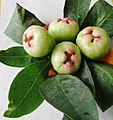Syzygium samarangense
| Syzygium samarangense | |
|---|---|

| |

| |
| Scientific classification | |
| Kingdom: | Plantae |
| Clade: | Tracheophytes |
| Clade: | Angiosperms |
| Clade: | Eudicots |
| Clade: | Rosids |
| Order: | Myrtales |
| Family: | Myrtaceae |
| Genus: | Syzygium |
| Species: | S. samarangense
|
| Binomial name | |
| Syzygium samarangense | |
| Synonyms[2] | |
| |
Syzygium samarangense is a species of flowering plant in the family Myrtaceae, native to an area that includes the Greater Sunda Islands, Malay Peninsula, and the Andaman and Nicobar Islands, but introduced in prehistoric times to a wider area[3] and now widely cultivated in the tropics. Common names in English include wax apple,[3] Java apple, Semarang rose-apple, and wax jambu.[4]
Description
Syzygium samarangense is a tropical tree growing to 12 m (39 ft) tall, with evergreen leaves 10–25 cm (4–10 in) long and 5–10 cm (2–4 in) broad. The leaves are elliptical, but rounded at the base; they are aromatic when crushed. The trunk is relatively short, with a wide – yet open – crown starting low on the tree. The bark is pinkish-gray in color, and flakes readily.[3][5]
The flowers are white to yellowish-white, 2.5 cm (1 in) diameter, with four petals and numerous stamens. They form in panicles of between three and 30 near branch tips. The resulting fruit is a bell-shaped, edible
When ripe, the fruit puff outwards, with a slight concavity in the middle of the underside of the "bell". Healthy wax apples have a light sheen to them. Despite its name, a ripe wax apple only resembles an apple on the outside in color. It does not taste like an apple, and it has neither the fragrance nor the density of an apple. Its flavor is similar to a snow pear, and the liquid-to-flesh ratio of the wax apple is comparable to a watermelon. Unlike either apple or watermelon, the wax apple's flesh has a very loose weave. The very middle holds a seed situated in a sort of cotton candy-like mesh. This mesh is edible, but flavorless. The color of its juice depends on the cultivar; it may be purple to entirely colorless.[citation needed]
Composition
Nutrition
| Nutritional value per 100 g (3.5 oz) | |
|---|---|
| Energy | 105 kJ (25 kcal) |
5.70 g | |
0.30 g | |
0.60 g | |
Niacin (B3) | 5% 0.800 mg |
| Vitamin C | 25% 22.3 mg |
| Minerals | Quantity %DV† |
| Calcium | 2% 29 mg |
| Iron | 0% 0.07 mg |
| Magnesium | 1% 5 mg |
| Phosphorus | 1% 8 mg |
| Potassium | 4% 123 mg |
| Sodium | 0% 0 mg |
| Zinc | 1% 0.06 mg |
| Other constituents | Quantity |
| Cholesterol | 0 mg |
| †Percentages estimated using US recommendations for adults,[6] except for potassium, which is estimated based on expert recommendation from the National Academies.[7] | |
Uses
Culinary
Several cultivars with larger fruit have been selected. In general, the paler or darker the color, the sweeter it is.[clarification needed]
In Southeast Asia, the black ones are nicknamed "Black Pearl" or "Black Diamond", while the very pale greenish-white ones, called "Pearl", are among the highest-priced ones in fruit markets. The fruit is often served uncut, but with the core removed, to preserve the unique bell-shaped presentation.
In the Indian Ocean islands cuisine, the fruit is frequently used in salads, as well as in lightly sautéed dishes. It is mainly eaten as a fruit and also used to make pickles (chambakka achar).
In the Philippines, its local name is macopa or makopa (its ancient name before colonialism, is dambo).[3] Because of their similarity in appearance, it is often confused with tambis (Syzygium aqueum),[8] although the latter is more commonly cultivated.
Gallery
-
Cross-section of the fruit
-
Fruit packed for sale
-
Fruit in the tree
-
Fruit for sale
-
Fruit in Puducherry
-
Tree in Puducherry
-
Red variety of fruit
-
Fruit with leaves
-
Lower trunk
-
"Black Pearl" wax apple
-
Fruits of Syzygium samarangense, for sale in West Bengal, India.
References
- . Retrieved 19 November 2021.
- ^ a b "Syzygium samarangense". World Checklist of Selected Plant Families (WCSP). Royal Botanic Gardens, Kew. Retrieved 16 July 2018.
- ^ ISBN 978-0-9610184-1-2.
- ^ "Syzygium samarangense (Blume) Merr. & L.M.Perry". Germplasm Resources Information Network. Agricultural Research Service, United States Department of Agriculture. Retrieved 14 March 2016.
- ^ a b "Syzygium samarangense". Singapore National Parks.
- ^ United States Food and Drug Administration (2024). "Daily Value on the Nutrition and Supplement Facts Labels". Retrieved 28 March 2024.
- )
- ISBN 9780851996387.














